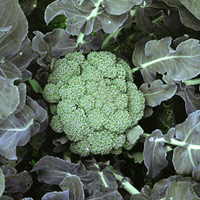Broccoli

A member of the cabbage family, broccoli is grown for its edible, immature flower heads. One of the most nutritious vegetables, broccoli contains high levels of antioxidants.
About This Plant
Broccoli prefers cool temperatures. In many regions it can be grown as both a spring and fall crop. Choose varieties touted for their abundant side shoots to extend the harvest; once the central head is harvested, these side shoots will continue to produce small heads for weeks.
Site Selection
Select a site with full sun and well-drained soil. Prepare the garden bed by using a garden fork or tiller to loosen the soil to a depth of 12 to 15 inches, then mix in a 2- to 4-inch layer of compost.
Planting Instructions
Start spring transplants indoors six to eight weeks before the last spring frost date, or buy nursery transplants three weeks before the last spring frost date. Where the weather is warm, select a variety that is bolt resistant. Set out hardened off transplants two weeks before the last spring frost. Space plants 18 inches apart. Protect transplants from hard frosts with newspapers, plastic cones, paper bags, or baskets. Provide a windbreak to reduce transplant shock and moisture loss. For fall crops, direct seed the broccoli in the garden 85 to 100 days before the average first fall frost date.
Care
Mulch plants to help keep soil moist, and water plants during the summer if rainfall is less than 1 inch per week. Contact your local County Extension office for controls of common broccoli pests such as flea beetles, cabbageworms, and cabbage loopers.
Harvesting
Harvest for peak quality when the buds of the head are firm and tight. If buds start to separate and the yellow petals inside start to show, harvest immediately.






 A member of the cabbage family, broccoli is grown for its edible, immature flower heads. One of the most nutritious vegetables, broccoli contains high levels of antioxidants.
A member of the cabbage family, broccoli is grown for its edible, immature flower heads. One of the most nutritious vegetables, broccoli contains high levels of antioxidants.